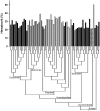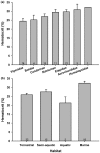Is aquatic life correlated with an increased hematocrit in snakes?
- PMID: 21359216
- PMCID: PMC3040194
- DOI: 10.1371/journal.pone.0017077
Is aquatic life correlated with an increased hematocrit in snakes?
Abstract
Background: Physiological adaptations that allow air-breathing vertebrates to remain underwater for long periods mainly involve modifications of the respiratory system, essentially through increased oxygen reserves. Physiological constraints on dive duration tend to be less critical for ectotherms than for endotherms because the former have lower mass-specific metabolic rates. Moreover, comparative studies between marine and terrestrial ectotherms have yet to show overall distinct physiological differences specifically associated with oxygen reserves.
Methodology/principal findings: We used phylogenetically informed statistical models to test if habitat affects hematocrit (an indicator of blood oxygen stores) in snakes, a lineage that varies widely in habitat use. Our results indicate that both phylogenetic position (clade) and especially habitat are significant predictors of hematocrit. Our analysis also confirms the peculiar respiratory physiology of the marine Acrochordus granulatus.
Conclusion/significance: Contrary to previous findings, marine snakes have significantly-albeit slightly-elevated hematocrit, which should facilitate increased aerobic dive times. Longer dives could have consequences for foraging, mate searching, and predation risks. Alternatively, but not exclusively, increased Hct in marine species might also help to fuel other oxygen-demanding physiological adaptations, such as those involved in osmoregulation.
Conflict of interest statement
Figures


Similar articles
-
Temperature independence of aquatic oxygen uptake in an air-breathing ectotherm and the implications for dive duration.Comp Biochem Physiol A Mol Integr Physiol. 2010 May;156(1):42-5. doi: 10.1016/j.cbpa.2009.12.009. Epub 2009 Dec 21. Comp Biochem Physiol A Mol Integr Physiol. 2010. PMID: 20026237
-
Dehydration and drinking behavior of the marine file snake Acrochordus granulatus.Physiol Biochem Zool. 2014 Jan-Feb;87(1):46-55. doi: 10.1086/673375. Epub 2013 Sep 30. Physiol Biochem Zool. 2014. PMID: 24457920
-
Benefits of thermal acclimation in a tropical aquatic ectotherm, the Arafura filesnake, Acrochordus arafurae.J Comp Physiol B. 2012 May;182(4):541-51. doi: 10.1007/s00360-011-0643-6. Epub 2012 Jan 8. J Comp Physiol B. 2012. PMID: 22227924
-
The diving paradox: new insights into the role of the dive response in air-breathing vertebrates.Comp Biochem Physiol A Mol Integr Physiol. 2004 Jul;138(3):263-8. doi: 10.1016/j.cbpb.2004.05.003. Comp Biochem Physiol A Mol Integr Physiol. 2004. PMID: 15313479 Review.
-
Pulmonary Structure and Function in Marine Snakes.Zoolog Sci. 2025 Feb;42(1). doi: 10.2108/zs240055. Zoolog Sci. 2025. PMID: 39932748 Review.
Cited by
-
A user's guide for understanding reptile and amphibian hydroregulation and climate change impacts.Conserv Physiol. 2025 Jun 16;13(1):coaf038. doi: 10.1093/conphys/coaf038. eCollection 2025. Conserv Physiol. 2025. PMID: 40575727 Free PMC article.
-
Ecological and life-history correlates of erythrocyte size and shape in Lepidosauria.J Evol Biol. 2022 May;35(5):708-718. doi: 10.1111/jeb.14004. Epub 2022 Apr 5. J Evol Biol. 2022. PMID: 35384114 Free PMC article.
-
Universal metabolic constraints shape the evolutionary ecology of diving in animals.Proc Biol Sci. 2020 May 27;287(1927):20200488. doi: 10.1098/rspb.2020.0488. Epub 2020 May 27. Proc Biol Sci. 2020. PMID: 32453989 Free PMC article.
-
Climate and foraging mode explain interspecific variation in snake metabolic rates.Proc Biol Sci. 2017 Nov 29;284(1867):20172108. doi: 10.1098/rspb.2017.2108. Proc Biol Sci. 2017. PMID: 29142118 Free PMC article.
References
-
- Kooyman G. Berlin: Springer-Verlag; 1989. Diverse Divers: Physiology and Behavior.
-
- Boyd IL. The behavioural and physiological ecology of diving. TREE. 1997;12:213–217. - PubMed
-
- Butler PJ, Jones DR. Physiology of diving of birds and mammals. Physiol Rev. 1997;77:837–899. - PubMed
-
- Brischoux F, Bonnet X, Cook TR, Shine R. Allometry of diving capacities: ectothermy versus endothermy. J Evol Biol. 2008;21:324–329. - PubMed
-
- Pough FH. The advantages of ectothermy for tetrapods. Am Nat. 1980;115:92–112.
Publication types
MeSH terms
Substances
LinkOut - more resources
Full Text Sources
Molecular Biology Databases

